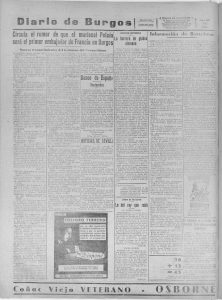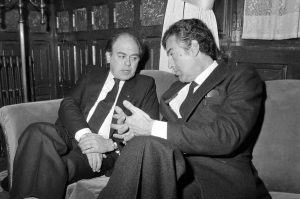Source: “Historia del Palacio de la Isla de Burgos (1883-12010)” de Isaac Rilova Pérez
Accident of Quintanilleja in 1891
On the night of September 23, 1891, a very serious railway accident occurred between the stations of Burgos and Quintanilleja. The express that came from San Sebastián collided with the mixed train, which was traveling in the opposite direction. The mixed travelers were saved thanks to the machinist, Pedro Jaca, who stopped in time and stayed at his post in front of an inevitable and frightening death.
Because of the magnitude of the tragedy, the royal family went to Burgos to attend, on October 13, a Requiem Mass for the victims of the accident.
During his stay in Burgos, the Muguiro family welcomed the royal family in the “Palacio de la Isla”, where they spent two days before returning to Madrid.

Visit of the Kings to the act of the Armed Forces in 1983
While the “Palacio de la Isla” was the seat of the “Junta of Castilla y León”, King Juan Carlos I, who was accompanied by Queen Sofia and her children, the Prince and the Infantas, had the deference to attend the presidency of the parade of the Week of the Armed Forces. He also visited the “Palacio de la Isla”. Demetrio Madrid, president of the “Junta”, offered his Majesty a leather-bound copy of the Statute of Castilla y León, and a chest that contained a replica of the keys of the “Palacio de la Isla”.

Visit of Marshal Pétain in 1939

On March 2, Marshal Pétain was appointed ambassador of France to Spain. This appointment raised controversy in both countries.
Marshal Pétain visited Burgos on March 23, 1939. He entered the Alonso Martínez square, after being escorted by the Mora Guard along Laín Calvo Street, while the San Marcial music band played the ‘Marseillaise’.
The speech of the French ambassador, delivered in the great hall of the palace of the Sixth Military Region of Burgos, was focused on establishing a pact by which Spain will maintain a neutral position in case of the outbreak of World War II.
In exchange, Spain would achieve the repatriation of Spanish refugees in France, as well as the restitution of Spanish gold seized by the French government after the Civil War.
The signing of the last report of war
In the Palacio de la Isla, the last report of the war of the Civil War was ruled and the decision was taken to remove Spain from the League of Nations at a meeting of the Council of Ministers and the AntiKomintern Pact was signed, signed between Germany and Japan, in which the hostility of both countries to the Communist International was declared. At the same time, the Palace was the place where the dictator Franco received European’personalities’ who marked European history, such as Heinrich Himmler, ideologist of the’final solution’ or General Pétain.
Visit of the Reichfürer Heinrich Himmler in 1940
Himmler was a high-ranking Nazi officer and one of the main leaders of the Nazi Party (NSDAP) during the National Socialist regime. He was also the ideologue of the’final solution’, the Third Reich’s plan to carry out the systematic elimination of the European Jewish population during the Second World War.
On October 19, 1940, after the Civil War, Himmler traveled to Burgos to know the “Capital of the Crusade”, the place from which Franco led the development of the war to victory. But above all, he wanted to make contact with the German information services that operated in the Miranda de Ebro concentration camp, where numerous Allied prisoners and prisoners of other nationalities were held.
He entered the city by the “Paseo del Espolón”, to go to the Cathedral, and next to the great cross of the fallen, he was received by the Burgos authorities.
After his visit to the Cathedral, Himmler moved to the Cartuja where he was received and accompanied by the prior.
His visit ended in the “Palacio de la Isla”, where he dined in the company of the General Director of Security, among other personalities.
Visit of the Catalan president Jordi Pujol in 1981
On November 26, 1981, President Pujol arrived in Burgos, where an official reception took place at the “Palacio de la Isla”. Upon his arrival, the president stamped his signature on the Book of Honor of the General Council of Castilla y León. The purpose of this visit was to dissipate the doubts that could be with regard to the autonomic process and to demonstrate that the Spain of the Autonomies was possible.
